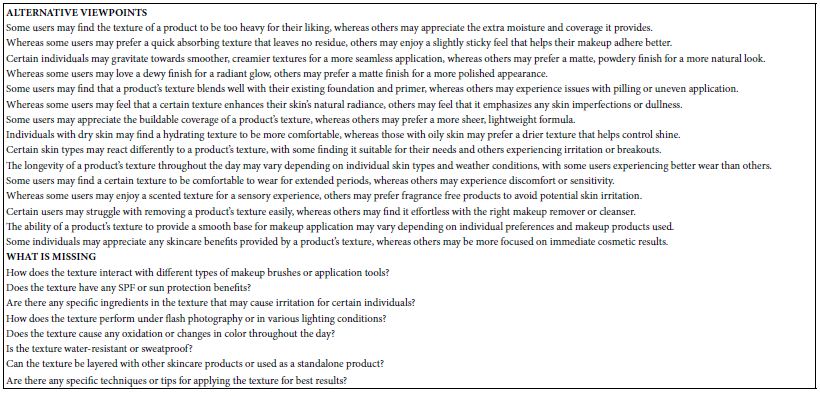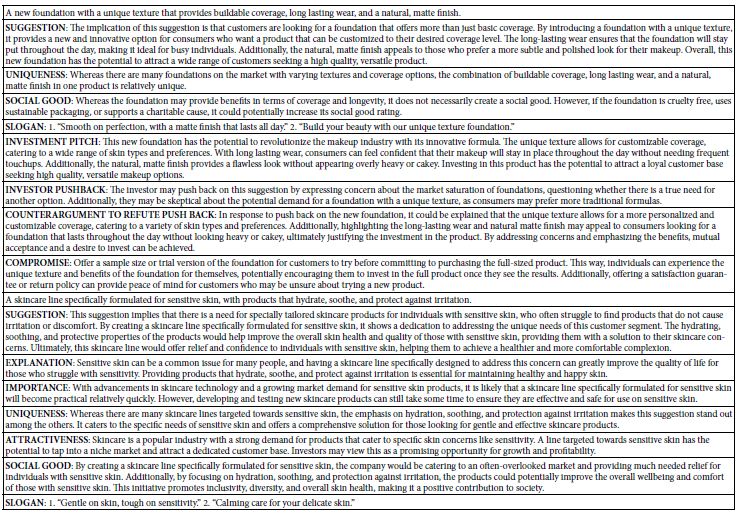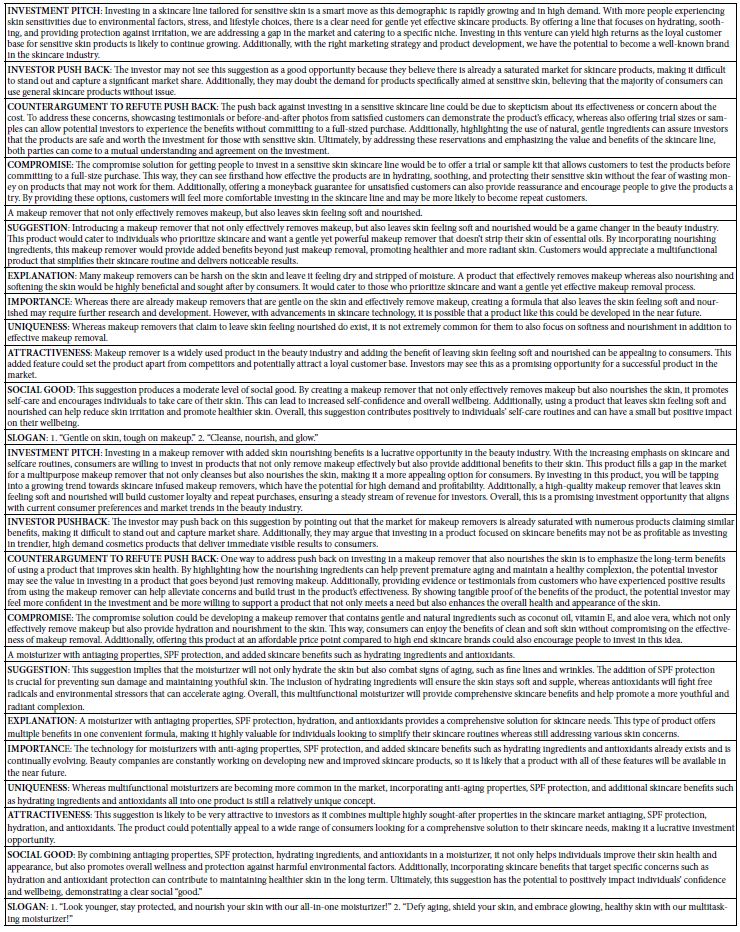Abstract
The paper shows how to create new product ideas using a combination of AI (ChatGPT 3.5) and Mind Genomics thinking and is based on the Mind Genomics platform, BimiLeap.com (Idea Coach feature). In this paper, the request was to have AI ask and answer questions about a possible cosmetic product for skin care. AI returns with 15 questions, and answers. This question-and-answer step can be repeated. Once the user closes the BimiLeap program, the AI applies creative thinking to the 15 answers to generate a set of innovations and each innovation idea is analyzed by AI. It is from these AI-suggested innovations that the user develops the product idea, in this case a lotion with an unusual fragrance. This early stage of the process is efficient, low-cost, and rapid-requiring minutes for the iteration and a few hours for the deeper analysis by AI.
Keywords
Cosmetic development, Generative AI, Mind Genomics, Product innovation
Introduction
Creating a new product has often been a situation of hit or miss, with many people hiring “experts” in the topic area, as well as experts in ideation regarding new ideas. With the widespread adoption of generative AI, such as ChatGPT 3.5, the questions arise as to the degree to which AI can help drive the ideation process. The ultimate results, of course, would have to be acceptable to consumers and would have to bring market success.
The Mind Genomics approach enriches the development process by providing a framework for understanding consumer perceptions and preferences. By segmenting the target market into distinct groups based on their unique responses to different stimuli, companies can tailor the product offering to each segment, increasing its relevance and appeal. This approach helps companies uncover hidden opportunities, identify niche markets, and optimize product positioning for maximum impact.
This paper focuses on the use of AI, coupled with Mind Genomics thinking, to drive the development of new ideas for the proposed product. This paper is the first of three connected papers on the process, with the materials in the first two papers generated by AI, and the materials in the third paper representing the response of actual people in the UK to the idea. All AI “material” was generated using the Mind Genomics platform, BimiLeap.com (Idea Coach feature).
Mind Genomics as a Coach, Which Drives the User to Ask the “Right Questions”
We begin with the example of a “tabula rasa,” a blank slate, and how Mind Genomics and AI fill that slate. As an example, consider 15 questions and answers in Table 1 that may arise in the development of new cosmetics. These 15 questions and answers were generated by the Mind Genomics platform, BimiLeap.com. The important thing to note about Table 1 is that in just a few moments, and with the correct software accessing generative AI, such as ChatGPT 3.5, the developer can access a “coach” to help navigate issues of knowledge and can receive suggestions which have aspects of guidance attached to them.
Table 1: AI and Mind Genomics as a coach. Instructions given to AI to provide 15 questions and answers about creating and marketing a cosmetic product.

Given the foregoing ability of AI, coupled with Mind Genomics thinking, to become a “partner” in the development process, let us follow the effort through. This first of three papers shows how to develop the basic ideas, even when at the inception of the project, there is no “inkling” about what to do.
Phase 1 — Thinking About the Process and Getting General Direction From AI
Table 2 presents the initial instructions to the AI platform about the process, and what AI returns. The assumption here is that the person writing the instructions to AI knows absolutely nothing about the topic.
Table 2: Instructions to the AI about how to think about the new product idea.

Phase 2 — Requesting Direction from AI for a Specific Product, a Cosmetic Product for the Skin
Using AI, the emerging science of Mind Genomics provides a novel method that generates a large number of original ideas in response to user instructions (e.g., AI instructions and prompts). As a standard practice, Mind Genomics generates a variety of questions, answers, and even full concepts that could not have been thought of otherwise by using AI algorithms to examine data and trends. Phase 2 uses AI to create targeted questions about the product, as shown in Table 3.
Phase 3 — Teaching Critical Thinking by Having AI Analyze Its Own Suggestions
AI further analyzes the ideas that it generates. After the “iteration” is finished and the material is returned to the user (see Table 3), the study can be temporarily closed. Afterwards, when the study is closed, AI automatically reviews its own production (see Table 3), focusing on a variety of alternative aspects.
Table 3: Fifteen targeted questions about the product generated by AI.

The remainder of this paper presents the output from AI as it reviews what it created (see Table 3), applying critical thinking and innovation aspects to the effort.
Table 4 begins the critical thinking by looking at the key ideas, themes, and perspectives touched on by the material in Table 3. The objective here is to identify the basic ideas and give the user some idea of the alternatives available. If the user had run five iterations at the start of the project, the BimiLeap platform would have returned with five different types of tables. Each iteration is subject to this same analysis—making it possible to learn a great deal about the project by simply doing 5-10 iterations, obtaining different questions—which in turn serve as the raw material for the AI analyses. By running 5-10 iterations with different questions, etc., the user generates 5-10 analyses, covering a great deal of ground.
Table 4: AI’s critical analyses of the questions shown in Table 3.

Critical Analysis Continued — Looking at the Audiences
Table 5 shows the next step in critical thinking for the 15 questions generated in Table 3. The top of Table 5 shows the audiences who might be interested in the product. The bottom of Table 5 shows the audiences who might be opposed to the product.
Steps to Innovation — Alternative Viewpoints and a Search for What Might Be Missing
Table 5: Interested versus opposing audiences for the issues/products raised in the 15 questions in this iteration.

A key benefit of the AI embedded in Mind Genomics is in the ability of AI to look at alternative points of view. The top part of Table 6 moves the effort towards alternative viewpoints, suggesting neither acceptance nor rejection of the idea but rather moving in another direction. The bottom half of Table 6 shows what might be missing.
Table 6: Alternative viewpoints, which move the thinking “out of the box” (top), and the search for what might be missing (bottom).

Suggested Innovations and AI’s Deep Analysis of Each Innovation From Various Perspectives
The final AI analysis of its own ideas is shown in Table 7. In this specific study, AI emerged with four “ideas” for new products on its own. For each “idea,” AI presents an automated, fairly rigorous proposition, comprising the analysis and suggestions for further business consideration.
Table 7: AI’s own deep analysis of four innovations that the AI itself generated.



Discussion and Conclusions
AI and Mind Genomics offer a new and potentially great deal of value when it comes to creating a new cosmetic product, such as a lotion. By harnessing the power of artificial intelligence, companies can use advanced algorithms and data analysis to develop innovative and effective products that cater to the diverse needs of consumers. AI can pose relevant questions, provide insightful answers, analyze its own responses, and think “outside the box” to generate new ideas and solutions that may not have been considered otherwise.
One of the key advantages of involving AI in the product development process is its ability to become a true partner in the early stages of design. By inputting information about the physical properties of various ingredients, as described by consumers, AI can generate formulations that are tailored to specific preferences and requirements. This not only streamlines the product development process but also ensures that the final product aligns with the expectations of the target market.
Moreover, AI can play a crucial role in shaping the marketing strategies for the new cosmetic product. By analyzing consumer behavior, preferences, and trends, AI can help companies identify the most effective messaging, channels, and campaigns to promote the product and drive sales. This data-driven approach ensures that marketing efforts are targeted and relevant, maximizing the impact and reach of the product in the market.
Using AI and Mind Genomics thinking in creating a new cosmetic product may significantly enhance the ability to drive innovation, efficiency, and consumer relevance in a fast, cost-efficient, and iterative fashion. By integrating these advanced technologies into the product development process, companies can unlock new opportunities, optimize product offerings, and deliver exceptional value to consumers. Through strategic partnerships with AI as a coach that formulates questions, provides answers, and offers raw material, companies can accelerate product development, enhance marketing strategies, and ultimately achieve success in the competitive cosmetic industry [1-9].
Acknowledgments
The authors gratefully acknowledge the foresight of Dr. Nenad Filipovic to bring this approach of Mind Genomics to Serbia and to encourage its use among students and professionals, as well as to publish the results of papers in the scientific, technical, and business literatures.
The authors wish to thank Vanessa Marie B. Arcenas and Angela Louise C. Aton for their ongoing help in preparing this and companion papers in this series.
References
- Cooper RG, McCausland T (2024) AI and new product Res Technol Manag 67: 70-75.
- Cooper RG (2024) The AI transformation of product innovation. Ind Mark Manag 119: 62-74.
- Coussa A, Bellissimo N, Poulia KA, Karavetian M (2024) Use of Mind Genomics for public health and wellbeing: Lessons from COVID-19 pandemic. Adv Biomed Health Sci 3: 72-78.
- Davidov S, al Humaidan M, Gere A, Cooper T, Moskowitz H (2021) Sequencing the “Dairy Mind using Mind Genomics to create an “MRI of consumer ” In: Moskowitz H, Kover A, Papajorgji P, editors. New Advances in the Dairy Industry. IntechOpen.
- King K (2019) Using artificial intelligence in marketing: How to harness AI and maintain the competitive London: Kogan Page Publishers.
- Moskowitz HR, Gofman A, Beckley J, Ashman H (2006) Founding a new science: Mind J Sens Stud 21: 266-307.
- Ogundipe DO, Babatunde SO, Abaku EA (2024) AI and product management: A theoretical overview from idea to market. Int J Manag Entrep Res 6: 950-969.
- Papajorgji P (2023) Knowledge as a service: The case of Mind EuroMediterranean 19: 34-47.
- Verganti R, Vendraminelli L, Iansiti M (2020) Innovation and design in the age of artificial intelligence. J Prod Innov Manag 37: 212-227.